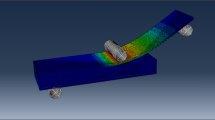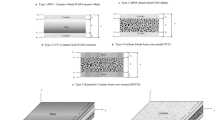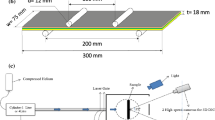Abstract
Three novel crack stopper designs for foam cored composite sandwich structures have been investigated with respect to their ability to deflect and arrest propagating face debond cracks. One of the new crack stoppers was similar to a previously developed design, whereas the two others were modified with layers of glass fibre fabric extending from the peel stopper tip into the face sheet, or into the face sheet/core interface. The novel designs were investigated under mode I dominated crack propagation conditions. Both quasi-static and fatigue loading scenarios were investigated. The mechanisms controlling crack propagation were studied using Thermoelastic Stress analysis (TSA) and Finite Element (FE) analysis. The TSA revealed significant new information about the local stress fields in the vicinity of the crack stopper tip as well as the fracture process zone. The first configuration in most cases was able to deflect debond cracks, albeit not in all cases, whereas it was incapable of achieving crack arrest. The two other designs performed better in that they consistently demonstrated the ability to deflect propagating cracks. Only the second design could arrest the cracks consistently as well. Detailed numerical fracture mechanics analyses confirmed and explained the experimental observations.
Access provided by CONRICYT-eBooks. Download conference paper PDF
Similar content being viewed by others
Keywords
- Foam cored composite sandwich structures
- Peel stoppers
- Thermoelastic stress analysis
- Fracture modelling
- Damage tolerance
15.1 Introduction
A well known weakness of sandwich structures is the bonding between the face sheet and core. To prevent the propagation of cracks from debonds at the interface of the face sheet and the core, ‘crack stoppers’ as shown in Fig. 15.1a may be introduced into the structure. The principle of the crack stopper is to deflect cracks away from the interface into the neighbourhood of the crack stopper wedge, and hence arrest its propagation. The present work studies the behaviour at the crack stopper wedge under mode I dominated loading. Thermoelastic stress analysis (TSA) is used to assess the stresses around the crack stopper during crack growth. The goal is to investigate local effects introduced by the crack stopper and to understand the fracture mechanism at the tri-material junction of the core, face sheet and crack stopper.
15.2 Experimental Investigation
As shown in Fig. 15.1a, the sandwich specimen consists of a PVC H100 foam core and glass/epoxy composite face sheets. The crack stopper was made from Permalock 9004 polyurethane (PU) adhesive. Three configurations of the crack stopper are studied. In configuration 1 (C1) the crack stopper is directly bonded to the foam; in configuration 2 (see C2 in Fig. 15.1b) a layer of fibre is moulded in the crack stopper and the fibre protruding from the crack stopper tip is attached to the face sheet. Configuration 3 (C3) places a layer of fibre at the foam/PU interface and the fibre away from the crack stopper is attached to the face sheet. The specimen is loaded in a mixed mode bending rig (see Fig. 15.1a). A long lever arm distance, c, is used to provide the mode I dominated loading.
The sandwich specimens were tested under fatigue loading; the crack growth paths are shown in Table 15.1. For the C1 specimens, in two cases the crack was not deflected. A common observation from the C1 specimens is that the crack at the tri-material junction shows a clear trend to kink back to the face sheet. Figure 15.2 shows the TSA data (ΔT/T is linearly proportional to the stress) obtained when crack reaches the tri-material junction. Figure 15.2a was obtained from C1. Large ΔT/T values are produced in the face sheet, on the right hand side, ahead of the crack stopper. In the results obtained from C3 (see Fig. 15.2b), the ΔT/T value ahead of the crack stopper tip is much smaller. The localized stress concentration ahead of the crack stopper tip can be an explanation for the crack propagation behaviour observed in C1.
15.3 Numerical Fracture Mechanics Study
A numerical fracture mechanics study was conducted using the commercial FE package ANSYS 15.0. The two scenarios of crack deflection and crack propagating along the horizontal interface (i.e. no crack deflection) at the tri-material junction were modelled for each peel stopper configuration. 8-node 2D plane stress elements (PLANE 183) with an average element size of 0.5 mm were used. Near the crack tip, the number of elements ranged from 36 to 144 with element sizes of 5–10 μm. Figure 15.3 shows the FE meshes corresponding to the three peel stopper configurations and the geometry of the sandwich beam model. The detailed models of different crack path scenarios around the tri-material junction for each configuration are shown in the images (a)–(f) in Fig. 15.3.
In particular, the case of crack deflection for the crack passing the tri-material junction was analysed. The predicted energy release rate and the mode-mixity values were compared to the experimentally observed crack paths. The paths consist of the “straight path” for the crack penetrating the peel stopper, and the “deflected path” for the crack deflecting at the peel stopper. The ability to achieve crack deflection wrt. the peel stopper angle θ was also investigated. The peel stopper angle, θ was varied from 5° to 30° with steps of 5°, and with a kinked crack length of 0.5 mm away from the corner as shown in Fig. 19. The 10° angle represents the tested configuration. The numerical study has shown that by increasing the peel stopper angle, crack deflection at the tri-material junction becomes increasingly more difficult. In the study the 10° angle was the one tested experimentally, since it represents the more practical solution.
15.4 Summary and Conclusions
It has been shown that the change of the crack stopper configuration results in different local effects at the tri-material junction which affect the crack propagation path. A numerical fracture mechanics study using finite element modelling was conducted to analyse and interpret the data so that a detailed fracture mechanics analysis could be used to explain the experimental observations. For the tested 10° angle, the energy release rate for the two possible crack paths, crack propagating straight and crack deflecting at the peel stopper were used to derive results on the crack deflection ability of each configuration. It was shown that if the ratio of the energy release rates for the two crack paths is equal (or near equal) to the ratio of the interface fracture toughnesses of the two crack paths, then crack deflection at the peel stopper is unlikely to occur as observed for C1. To ensure crack deflection it was found that the interface fracture toughness of the straight path must be large compared to the interface fracture toughness of the deflected crack path. By placing/embedding fibres in front of the peel stopper tip in C2 and C3 the desired behavior was achieved and the crack is deflected every time, as was confirmed in the experiments.
The work presented is based on recently published work [1, 2].
References
Wang, W., Fruehmann, R.K., Dulieu-Barton, J.M.: Application of digital image correlation to address complex motions in thermoelastic stress analysis. Strain 51(5), 405–418 (2015). doi:10.1111/str.12151
Wang, W., Martakos, G., Dulieu-Barton, J.M., Andreasen, J.H., Thomsen, O.T.: Fracture behaviour at tri-material junctions of crack stoppers in sandwich structures. Compos. Struct. 133, 818–833 (2015). doi:10.1016/j.compstruct.2015.07.060
Acknowledgements
The work presented was co-sponsored by the University of Southampton and the Danish Council for Independent Research | Technology and Production Sciences (FTP), under the research project ‘Enhanced Performance of Sandwich Structures by Improved Damage Tolerance’ (‘SANTOL’). The financial support received is gratefully acknowledged. The foam material supported by DIAB AB Sweden is highly appreciated.
Author information
Authors and Affiliations
Corresponding author
Editor information
Editors and Affiliations
Rights and permissions
Copyright information
© 2017 The Society for Experimental Mechanics, Inc.
About this paper
Cite this paper
Wang, W., Martakos, G., Dulieu-Barton, J.M., Thomsen, O.T. (2017). Experimental and Numerical Investigation of Novel Crack Stopper Concepts for Lightweight Foam Cored Sandwich Structures. In: Zehnder, A., et al. Fracture, Fatigue, Failure and Damage Evolution, Volume 8. Conference Proceedings of the Society for Experimental Mechanics Series. Springer, Cham. https://doi.org/10.1007/978-3-319-42195-7_15
Download citation
DOI: https://doi.org/10.1007/978-3-319-42195-7_15
Published:
Publisher Name: Springer, Cham
Print ISBN: 978-3-319-42194-0
Online ISBN: 978-3-319-42195-7
eBook Packages: EngineeringEngineering (R0)







